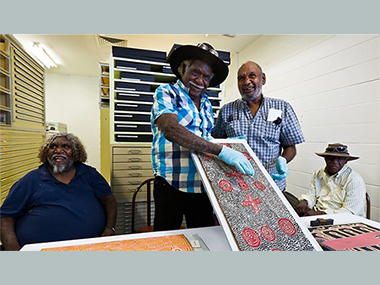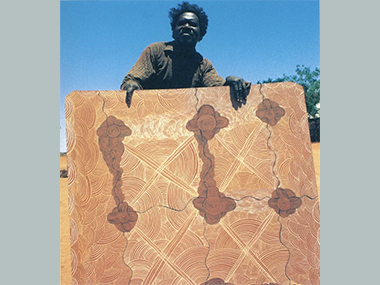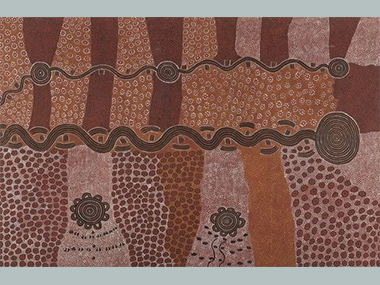LONG JACK PHILLIPUS 1932-2020

The four wise men, co-curators for MAGNT's 'Tjungungutja' exhibition - Long Jack Phillipus at the centre of proceedings
Jeremy Eccles | 08.09.20
Author: Jeremy Eccles
News source: Research
Kumantjayi Long Tjakamarra, the last of the founding painters at Papunya, has died. An era has come to an end. The 88-year-old Warlpiri man, who lived on independently in Papunya after his Pintupi painting colleagues left for their Countries further west, died in hospital in Alice Springs in late August surrounded by family.
He inherited rights in the renowned Rain Dreaming site of Kalipinypa from both his parents and in 2015, accompanied family members and countrymen on a visit there as the site’s senior custodian. Soon after he celebrated the awesome power of the ancestral storms at Kalipinypa as the subject of his final canvas for Papunya Tjupi Arts, the art centre whose creation he oversaw.
So ended an art career spanning more than four decades. For, in Geoffrey Bardon’s book, 'Papunya: A Place Made After the Story', the author reports that Tjakamarra was the first to apply his brush to the walls of the Papunya school, showing his fellow groundsman Billy Stockman “by example and direction” how to start the small murals that preceded the famous Honey Ant Mural project. He was not then 40 but had the backing of Old Bert Tjakamarra, his brother-in-law, to take the radical step of revealing cultural material in his art.
In fact, though, according to Vivien Johnson's authoritative 'Lives of the Papunya Tula Artists', Tjakamarra preferred to paint his Possum Dreaming stories from Ngamarunya, well into the Gibson Desert, Country he owned by right of birth. The epithet 'Long' became attached to his name when his family came in from the deserts to Haasts Bluff when he was a teenager and already 188cms tall. “His height enhances the aura of dignity that surrounds him”, reported Peter Fannin, one of the early Papunya Tula Artists managers, who went on to add that Phillipus was a rare teetotaller in Papunya, encouraged by his strong sense of religion – both traditional and Lutheran. He was later ordained as a Lutheran pastor.
In art, he won the NT Golden Jubilee Art Award and took out first prize in the Alice Award in the 80s. In both 1975, and then again in the 90s, he was elected Chair of PTA by his fellow artists. Famously, he was quoted as assessing the importance of Papunya Tula Artists, “We started it, like a bushfire this painting business, and it went every way - north, east, south, west. Papunya in the middle.”
But perhaps Tjakamarra's most enduring role has come as the elder arbiter of which of those pioneering boards the rest of the world can see today. This emerged from the important catalogue accompanying the Museum & Art Gallery of the NT's Tjungungutja exhibition – seen in Darwin and Alice. Major research had been done in the years after 2012 when the gallery first announced its intention to reveal the 226 boards that its pioneering Director, Colin Jack-Hinton had had the prescience to buy in the 70s. And the arbitration involved a curatorium that presented the final exhibition. It was coordinated by Luke Scholes (ex-Papunya Tula Artists and now Indigenous curator at MAGNT), and led by Long Jack Phillipus Tjakamarra and his skin 'brother' and long-time artist, Michael Nelson Jagamara, Bobby West Tjupurrula (son of first artist, Freddy West Tjakamarra), and Joseph Jurrah Tjapaltjarri (son of Charlie Tjaruru Tjungarrayi), and the now-dead Kumantjayi Anderson, a descendant of Old Bert Tjakamarra, one of the senior men at Papunya who approved the start of painting.
It was they who declared that 63 of the MAGNT boards are 'restricted' because “vulnerable people from relevant Indigenous communities” (in an anthropologist's words) may “see something that doesn't belong to us”, as one of the co-curators explained it. It's not surprising that the secret/sacred might have slipped out when John Kean – another essayist in the catalogue, who worked for PTA in the early days – could pronounce: “The efflorescence of imagery that struck in the hothouse conditions of the Men's Painting Room will never be repeated. For these works were created at the moment when the epic Songlines that connect Aboriginal Australia were unveiled”.
As I reported in July, a major canvas by Tjakamarra 'Untitled' (Kalipinya) (1972) was brought to auction then by Bonhams and Kean (once again) was quoted as saying that it typified the compositional breakthroughs that occurred in the Men’s Painting Room at Papunya in the months between the departure of Geoffrey Bardon in August and the arrival of the next art adviser, Peter Fannin in December. “It was a period of amazing stylistic diversity without anyone supervising,” he said. “To me, it’s one of the most exciting times because people are doing all sorts of things … they are painting with intention.”
There will no doubt be much mourning and remembering next weekend at the Desert Mob exhibition and symposium in Alice for this significant Man of Art.
Share this:
»  del.icio.us
»
del.icio.us
»  Digg it
»
Digg it
»  reddit
»
reddit
»  Google
»
Google
»  StumbleUpon
»
StumbleUpon
»  Technorati
»
Technorati
»  Facebook
Facebook
Contact Details

A 1972 photo of Long Jack with the major Water Dreaming painting that sold for $230,000 at a recent Bonhams auction.

'Travels of the Snake Larru Larru' (1981) by Kumantjayi Long Tjakamarra in the Art gallery of NSW collection
Further Research
Artists: Billy Stockman Tjapaltjarri | Bobby West Tjupurrula | Charlie Tjaruru Tjungarrayi | Freddy West Tjakamarra | Joseph Jurrah Tjapaltjarri | Long Jack Phillipus Tjakamarra | Michael Nelson Jagamara | Old Bert Tjakamarra
News Tags: Geoffrey Bardon | Jeremy Eccles | John Kean | Luke Scholes | Papunya Tjupi Art | Papunya Tula Artists | Peter Fannin | Tjungungutja
News Archive
- 13.10.20 | The Ebes Collection
- 12.10.20 | Sun Shines on the Wiradjuri Festival
- 06.10.20 | Hunter Valley Indigenous Cultural Hub and Museum Set to Go
- 06.10.20 | New Art Gallery to Open in Granville
- 02.10.20 | Maliwawa Rock Art
- 02.10.20 | Wonnangatta
- 25.09.20 | Movement at the Station
- 25.09.20 | Archie Has First Aboriginal Winner
- 17.09.20 | SUNSHINE SUPERGIRL
- 17.09.20 | Why not the Wynne?
- 08.09.20 | LONG JACK PHILLIPUS 1932-2020
- 02.09.20 | Consulting the Industry
- 27.08.20 | Goodies from Canberra
- 26.08.20 | Aboriginal Art is “An Exceptional Art Form”
- 25.08.20 | Tarnanthi 2020
Advertising

